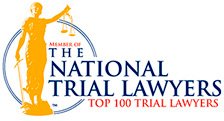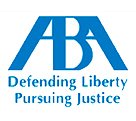Parents' Quick Guide to IDEA and Section 504
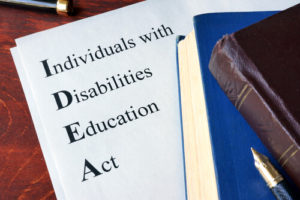
If you are the parent of a child with special needs, you need to know about the rights your child has under the Individuals with Disabilities Education Act (IDEA) and Section 504 of the Rehabilitation Act of 1973. These laws provide important protections to help your child get the most from education, public services and other aspects of daily life.
While IDEA and Section 504 are somewhat complex pieces of legislation, the intent of this page is to help parents of children with special needs understand how the laws can help them secure a brighter future for their children.
An Overview of What Parents Need to Know About IDEA
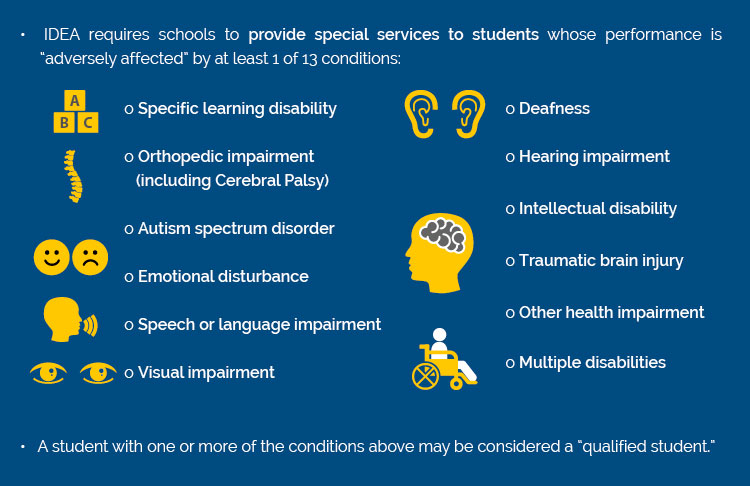
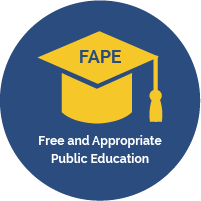 IDEA entitles qualified students to a Free and Appropriate Public Education (FAPE) in the Least Restrictive Environment (LRE).
IDEA entitles qualified students to a Free and Appropriate Public Education (FAPE) in the Least Restrictive Environment (LRE).- Schools must provide qualified students with an “education that emphasizes special education and related services designed to meet their unique needs and prepare them for further education, employment, and independent living.” The cost of providing education is paid by the school, not the parents. This is what is meant by a Free and Appropriate Public Education (FAPE).
- Least Restrictive Environment (LRE) means that qualified students are taught with non-disabled students to the maximum extent appropriate. In other words, they should be in a regular classroom as much as possible instead of being separated into a different class.
- IDEA requires public schools to develop an Individualized Educational Plan (IEP) for each qualified student. This plan provides specific details about how the school will fulfill its duty to provide the student with a Free and Appropriate Public Education (FAPE) in the Least Restrictive Environment (LRE).
- Parents and teachers are encouraged to provide input about the student’s IEP and empowered to question decisions that they believe are inappropriate for the student.
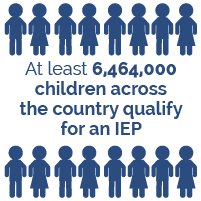 IDEA requires schools to provide students with the assistive technology needed for education. Assistive technology includes virtually any device that increases, maintains or improves the capabilities of a student with disabilities. A few examples include specialized computer programs to assist with writing, tools to help students with impaired vision to read, and desk and seat modifications to accommodate a wheelchair.
IDEA requires schools to provide students with the assistive technology needed for education. Assistive technology includes virtually any device that increases, maintains or improves the capabilities of a student with disabilities. A few examples include specialized computer programs to assist with writing, tools to help students with impaired vision to read, and desk and seat modifications to accommodate a wheelchair.- At least 6,464,000 children across the country qualify for an IEP (source: National Center for Educational Statistics).
An Overview of What Parents Need to Know About Section 504
- Section 504 applies to children who have a physical or mental impairment that “substantially limits” at least one of the child’s “major life activities.” Also covered are children who have a record of such an impairment or are regarded as having such an impairment.
- A few examples of “major life activities” under Section 504 include:

- Section 504 is more expansive than IDEA. In other words, a child may be entitled to Section 504 benefits even if the child does not meet IDEA’s definition of a “child with a disability.”
- Like IDEA, Section 504 entitles qualified children to a Free and Appropriate Public Education (FAPE).
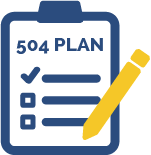 Similar to an Individualized Education Program (IEP) under IDEA, a “504 Plan” spells out how the school system will accommodate a qualified child in order to provide a FAPE.
Similar to an Individualized Education Program (IEP) under IDEA, a “504 Plan” spells out how the school system will accommodate a qualified child in order to provide a FAPE.- Section 504 prohibits bullying or harassment of students based on a physical or mental impairment.
- Section 504 applies to more than just the classroom. It extends to, for example:
- Athletics and other extracurricular clubs and activities
- Special programs and assemblies
- Playgrounds
- Field trips
- Band programs
- Graduation ceremonies
- At least 433,980 students across the United States have Section 504 plans (source: Education Week).

 IDEA entitles qualified students to a Free and Appropriate Public Education (FAPE) in the Least Restrictive Environment (LRE).
IDEA entitles qualified students to a Free and Appropriate Public Education (FAPE) in the Least Restrictive Environment (LRE). IDEA requires schools to provide students with the assistive technology needed for education. Assistive technology includes virtually any device that increases, maintains or improves the capabilities of a student with disabilities. A few examples include specialized computer programs to assist with writing, tools to help students with impaired vision to read, and desk and seat modifications to accommodate a wheelchair.
IDEA requires schools to provide students with the assistive technology needed for education. Assistive technology includes virtually any device that increases, maintains or improves the capabilities of a student with disabilities. A few examples include specialized computer programs to assist with writing, tools to help students with impaired vision to read, and desk and seat modifications to accommodate a wheelchair. Similar to an Individualized Education Program (IEP) under IDEA, a “504 Plan” spells out how the school system will accommodate a qualified child in order to provide a FAPE.
Similar to an Individualized Education Program (IEP) under IDEA, a “504 Plan” spells out how the school system will accommodate a qualified child in order to provide a FAPE.




